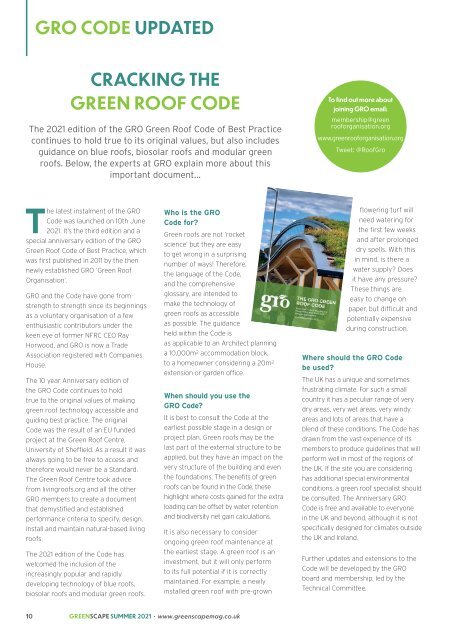Summer '21
Create successful ePaper yourself
Turn your PDF publications into a flip-book with our unique Google optimized e-Paper software.
GRO CODE UPDATED<br />
CRACKING THE<br />
GREEN ROOF CODE<br />
The 2021 edition of the GRO Green Roof Code of Best Practice<br />
continues to hold true to its original values, but also includes<br />
guidance on blue roofs, biosolar roofs and modular green<br />
roofs. Below, the experts at GRO explain more about this<br />
important document…<br />
To find out more about<br />
joining GRO email:<br />
membership@green<br />
rooforganisation.org<br />
www.greenrooforganisation.org<br />
Tweet: @RoofGro<br />
The latest instalment of the GRO<br />
Code was launched on 10th June<br />
2021. It’s the third edition and a<br />
special anniversary edition of the GRO<br />
Green Roof Code of Best Practice, which<br />
was first published in 2011 by the then<br />
newly established GRO ‘Green Roof<br />
Organisation’.<br />
GRO and the Code have gone from<br />
strength to strength since its beginnings<br />
as a voluntary organisation of a few<br />
enthusiastic contributors under the<br />
keen eye of former NFRC CEO Ray<br />
Horwood, and GRO is now a Trade<br />
Association registered with Companies<br />
House.<br />
The 10 year Anniversary edition of<br />
the GRO Code continues to hold<br />
true to the original values of making<br />
green roof technology accessible and<br />
guiding best practice. The original<br />
Code was the result of an EU funded<br />
project at the Green Roof Centre,<br />
University of Sheffield. As a result it was<br />
always going to be free to access and<br />
therefore would never be a Standard.<br />
The Green Roof Centre took advice<br />
from livingroofs.org and all the other<br />
GRO members to create a document<br />
that demystified and established<br />
performance criteria to specify, design,<br />
install and maintain natural-based living<br />
roofs.<br />
The 2021 edition of the Code has<br />
welcomed the inclusion of the<br />
increasingly popular and rapidly<br />
developing technology of blue roofs,<br />
biosolar roofs and modular green roofs.<br />
Who is the GRO<br />
Code for?<br />
Green roofs are not ‘rocket<br />
science’ but they are easy<br />
to get wrong in a surprising<br />
number of ways! Therefore,<br />
the language of the Code,<br />
and the comprehensive<br />
glossary, are intended to<br />
make the technology of<br />
green roofs as accessible<br />
as possible. The guidance<br />
held within the Code is<br />
as applicable to an Architect planning<br />
a 10,000m 2 accommodation block,<br />
to a homeowner considering a 20m 2<br />
extension or garden office.<br />
When should you use the<br />
GRO Code?<br />
It is best to consult the Code at the<br />
earliest possible stage in a design or<br />
project plan. Green roofs may be the<br />
last part of the external structure to be<br />
applied, but they have an impact on the<br />
very structure of the building and even<br />
the foundations. The benefits of green<br />
roofs can be found in the Code, these<br />
highlight where costs gained for the extra<br />
loading can be offset by water retention<br />
and biodiversity net gain calculations.<br />
It is also necessary to consider<br />
ongoing green roof maintenance at<br />
the earliest stage. A green roof is an<br />
investment, but it will only perform<br />
to its full potential if it is correctly<br />
maintained. For example, a newly<br />
installed green roof with pre-grown<br />
flowering turf will<br />
need watering for<br />
the first few weeks<br />
and after prolonged<br />
dry spells. With this<br />
in mind, is there a<br />
water supply? Does<br />
it have any pressure?<br />
These things are<br />
easy to change on<br />
paper, but difficult and<br />
potentially expensive<br />
during construction.<br />
Where should the GRO Code<br />
be used?<br />
The UK has a unique and sometimes<br />
frustrating climate. For such a small<br />
country it has a peculiar range of very<br />
dry areas, very wet areas, very windy<br />
areas and lots of areas that have a<br />
blend of these conditions. The Code has<br />
drawn from the vast experience of its<br />
members to produce guidelines that will<br />
perform well in most of the regions of<br />
the UK. If the site you are considering<br />
has additional special environmental<br />
conditions, a green roof specialist should<br />
be consulted. The Anniversary GRO<br />
Code is free and available to everyone<br />
in the UK and beyond, although it is not<br />
specifically designed for climates outside<br />
the UK and Ireland.<br />
Further updates and extensions to the<br />
Code will be developed by the GRO<br />
board and membership, led by the<br />
Technical Committee.<br />
10 GREENSCAPE SUMMER 2021 • www.greenscapemag.co.uk

















